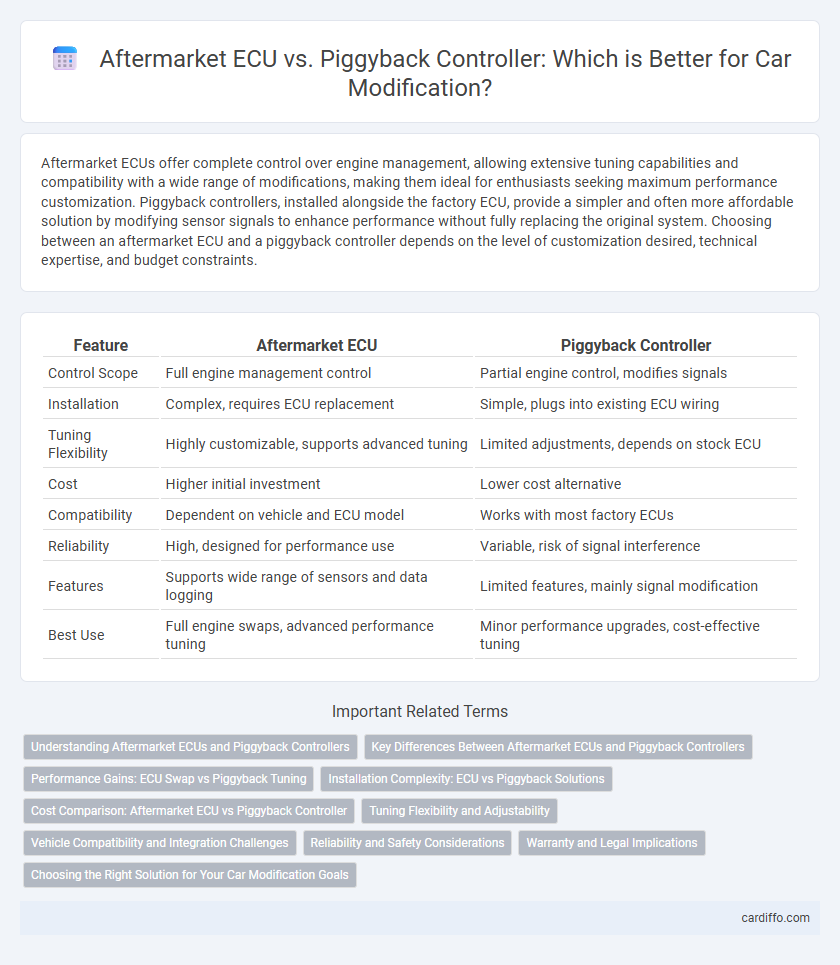Aftermarket ECUs offer complete control over engine management, allowing extensive tuning capabilities and compatibility with a wide range of modifications, making them ideal for enthusiasts seeking maximum performance customization. Piggyback controllers, installed alongside the factory ECU, provide a simpler and often more affordable solution by modifying sensor signals to enhance performance without fully replacing the original system. Choosing between an aftermarket ECU and a piggyback controller depends on the level of customization desired, technical expertise, and budget constraints.
Table of Comparison
| Feature | Aftermarket ECU | Piggyback Controller |
|---|---|---|
| Control Scope | Full engine management control | Partial engine control, modifies signals |
| Installation | Complex, requires ECU replacement | Simple, plugs into existing ECU wiring |
| Tuning Flexibility | Highly customizable, supports advanced tuning | Limited adjustments, depends on stock ECU |
| Cost | Higher initial investment | Lower cost alternative |
| Compatibility | Dependent on vehicle and ECU model | Works with most factory ECUs |
| Reliability | High, designed for performance use | Variable, risk of signal interference |
| Features | Supports wide range of sensors and data logging | Limited features, mainly signal modification |
| Best Use | Full engine swaps, advanced performance tuning | Minor performance upgrades, cost-effective tuning |
Understanding Aftermarket ECUs and Piggyback Controllers
Aftermarket ECUs replace the factory engine control unit entirely, allowing full customization of engine parameters for improved performance and efficiency. Piggyback controllers work alongside the stock ECU, modifying sensor signals to enhance engine operation without extensive reprogramming. Understanding the differences ensures optimal tuning strategies tailored to specific vehicle modifications and performance goals.
Key Differences Between Aftermarket ECUs and Piggyback Controllers
Aftermarket ECUs offer complete control over engine parameters, enabling full customization and tuning of fuel maps, ignition timing, and boost levels, unlike piggyback controllers which only modify signals from the stock ECU to adjust specific functions without replacing it. Aftermarket ECUs typically support advanced features such as standalone operation, data logging, and compatibility with various sensors, providing superior flexibility for performance modifications. Piggyback controllers are generally easier to install and more cost-effective but offer limited tuning scope compared to the comprehensive capabilities of aftermarket ECUs.
Performance Gains: ECU Swap vs Piggyback Tuning
ECU swaps deliver significant performance gains by providing full control over fuel maps, ignition timing, and boost pressure, allowing optimized engine management tailored for high-performance applications. Piggyback controllers offer a less invasive tuning solution by intercepting and modifying sensor signals, but their performance improvements are typically limited compared to ECU swaps. Choosing an ECU swap enables more aggressive tuning and better power output, whereas piggyback tuning serves as a safer, less expensive option with moderate enhancements.
Installation Complexity: ECU vs Piggyback Solutions
Aftermarket ECU installations typically require extensive rewiring and precise calibration, demanding professional expertise for optimal performance and reliability. Piggyback controllers offer a simpler plug-and-play setup, connecting directly to the stock ECU signals with minimal modification to the vehicle's wiring harness. The reduced installation complexity of piggyback units makes them a popular choice for enthusiasts seeking enhanced engine tuning without the risk of extensive electronic reprogramming.
Cost Comparison: Aftermarket ECU vs Piggyback Controller
Aftermarket ECUs typically cost between $800 and $2,500, offering full engine management capabilities with extensive tuning flexibility. Piggyback controllers are generally more affordable, ranging from $300 to $1,200, and work by modifying signals to the stock ECU without replacing it. The higher initial investment in aftermarket ECUs often results in greater performance gains and customization, while piggyback controllers provide a budget-friendly solution for moderate tuning needs.
Tuning Flexibility and Adjustability
Aftermarket ECU offers superior tuning flexibility and adjustability by granting full control over engine parameters such as fuel maps, ignition timing, and boost pressure, enabling precise customization for various driving conditions. Piggyback controllers, while easier to install, provide limited adjustability as they modify signals from the stock ECU rather than replacing it entirely, restricting the range of tuning options. For enthusiasts seeking comprehensive engine management and advanced tuning capabilities, an aftermarket ECU remains the preferred choice.
Vehicle Compatibility and Integration Challenges
Aftermarket ECUs offer comprehensive control by replacing the stock unit, ensuring seamless integration with a wide range of vehicles but often require extensive customization for compatibility. Piggyback controllers work alongside the existing ECU, providing easier installation and retaining factory settings, yet may encounter limitations with complex vehicle systems or newer models. Both options demand careful consideration of the vehicle's electronic architecture to avoid integration challenges and achieve optimal performance.
Reliability and Safety Considerations
Aftermarket ECUs provide extensive control over engine parameters, offering optimized performance but may introduce risks if not properly calibrated, potentially compromising reliability and safety. Piggyback controllers, which modify signals to the stock ECU, maintain factory safety protocols, resulting in higher reliability and minimized risk during modifications. Choosing between the two depends on the balance between desired customization and the importance of preserving OEM safety standards.
Warranty and Legal Implications
Aftermarket ECUs often require extensive modifications to the vehicle's original wiring and software, which can void the manufacturer's warranty and raise legal concerns regarding emissions compliance. Piggyback controllers, by contrast, work alongside the factory ECU without replacing it, minimizing warranty risks and often maintaining emissions certification. Understanding the specific regulations and warranty terms is crucial when choosing between these tuning options to avoid potential legal and financial repercussions.
Choosing the Right Solution for Your Car Modification Goals
Selecting the right engine management system depends on your modification goals and budget. Aftermarket ECUs offer complete control over fuel, ignition, and boost, ideal for extensive engine builds requiring maximum customization. Piggyback controllers provide a simpler, cost-effective solution by modifying signals from the stock ECU, suitable for moderate tuning without replacing the factory system.
Aftermarket ECU vs Piggyback Controller Infographic

 cardiffo.com
cardiffo.com